Zscaler Bundle
How Does Zscaler Revolutionize Cybersecurity?
In today's dynamic digital landscape, where cyber threats constantly evolve, Zscaler stands at the forefront of cloud security innovation. This cloud-delivered security platform has redefined how organizations protect their data and users, moving away from traditional on-premises solutions. With a robust financial performance and expanding global presence, Zscaler is a pivotal force in the Secure Access Service Edge (SASE) market.
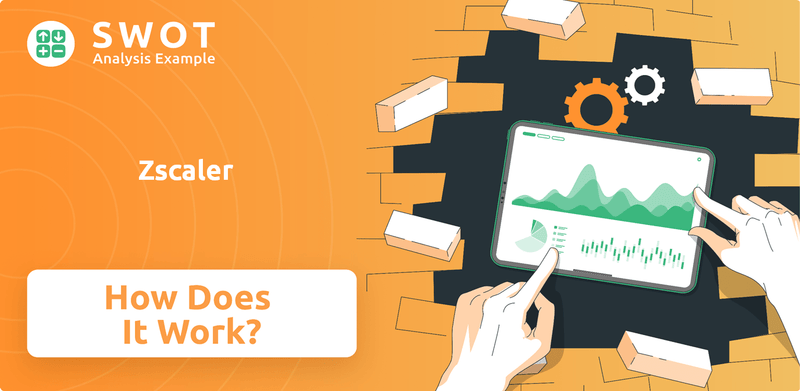
Understanding Zscaler SWOT Analysis is crucial for anyone navigating the complexities of cloud security. Its core offerings, encompassing Secure Web Gateway, Cloud Firewall, and Cloud Sandbox, are essential for businesses embracing remote work and cloud adoption. This comprehensive analysis will explore how Zscaler works, examining its value proposition and strategies to generate revenue, offering a clear picture of its business model and impact on the cybersecurity landscape, including its Zero trust approach.
What Are the Key Operations Driving Zscaler’s Success?
The core operations of Zscaler revolve around its Zero Trust Exchange platform. This cloud-native security architecture is designed to securely connect users and devices to applications and data, regardless of their location. It addresses the challenges posed by modern enterprises and the rise of remote work.
Zscaler's value proposition lies in eliminating the need for traditional perimeter-based security. The platform acts as an intelligent switchboard, inspecting all traffic inline and applying security policies before connecting users to their destinations. This approach significantly reduces the attack surface and prevents advanced threats.
The company offers secure web gateway, cloud firewall, cloud sandbox, and data loss prevention capabilities through Zscaler Internet Access (ZIA). Zscaler Private Access (ZPA) provides secure, direct-to-app connectivity, replacing VPNs. These services cater to a diverse customer base, including large enterprises, government agencies, and small to medium-sized businesses.
Zscaler operates a massive global cloud infrastructure, comprising over 150 data centers worldwide. This distributed architecture brings security closer to the user, reducing latency and improving performance. This extensive network is crucial for delivering its security services globally.
Zscaler continuously enhances its AI-driven threat intelligence, expands platform capabilities, and integrates with other security and IT solutions. This commitment to innovation ensures that Zscaler remains at the forefront of cloud security. The company invests heavily in R&D to stay ahead of emerging threats.
Zscaler primarily uses a direct sales approach, supported by a strong network of channel partners and managed security service providers (MSSPs). This multi-channel strategy allows Zscaler to reach a wide range of customers and provide tailored solutions. The company's sales teams are focused on enterprise clients.
A key differentiator for Zscaler is its proxy-based architecture, which enables full inline inspection of encrypted traffic at scale. This capability is critical for effective cybersecurity in today's threat landscape. This architecture allows for comprehensive threat detection and prevention.
Zscaler's core capabilities translate into significant customer benefits, including enhanced security, simplified IT operations, reduced costs, and improved user experience. The platform's Zero Trust approach minimizes the attack surface and prevents data breaches. The company's focus on cloud security has positioned it well in the market.
- Enhanced Security: Zscaler's platform provides robust protection against a wide range of cyber threats.
- Simplified IT Operations: The cloud-native architecture reduces the complexity of managing security infrastructure.
- Reduced Costs: By eliminating the need for hardware appliances, Zscaler helps reduce capital and operational expenditures.
- Improved User Experience: Zscaler's distributed architecture ensures fast and reliable access to applications and data.
Zscaler SWOT Analysis
- Complete SWOT Breakdown
- Fully Customizable
- Editable in Excel & Word
- Professional Formatting
- Investor-Ready Format
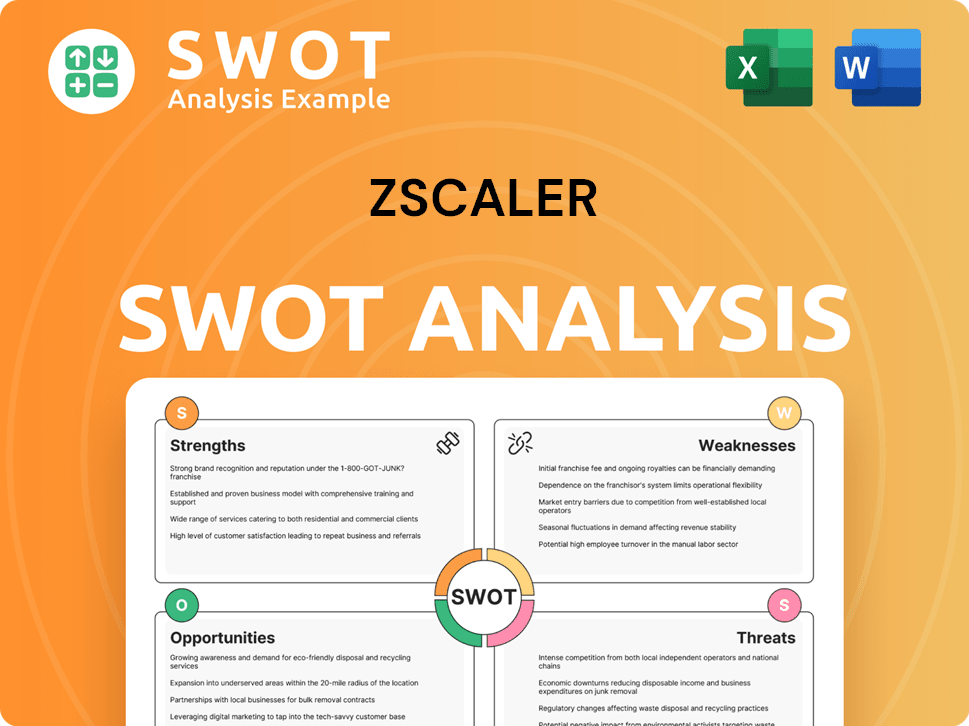
How Does Zscaler Make Money?
The primary revenue streams for Zscaler stem from subscriptions to its cloud security platform. This platform offers a suite of security services, including Secure Web Gateway, Cloud Firewall, and Data Loss Prevention. Revenue is largely determined by the number of users or devices protected and the specific security services subscribed to.
In its fiscal second quarter of 2024, Zscaler reported subscription revenue of $502.4 million, a significant 37% increase year-over-year. This underscores subscriptions as the dominant revenue source. Additional revenue comes from professional services, such as implementation, training, and consulting.
Zscaler's approach to generating revenue involves several key strategies. They employ tiered pricing, offering different service levels to meet varied customer needs and budgets. Additionally, the company focuses on cross-selling and upselling additional security modules to existing clients as their security requirements evolve. The scalability of its cloud platform also contributes to efficient customer onboarding and service expansion.
Zscaler's monetization strategies are multifaceted, designed to maximize revenue and customer value. These strategies include tiered pricing, cross-selling, and leveraging the scalability of its cloud platform. These approaches allow Zscaler to cater to a wide range of customers and adapt to their changing security needs. If you want to learn more about the Competitors Landscape of Zscaler, you can find more information.
- Tiered Pricing: Offers various service levels (e.g., Business, Transformation, Evolve) with different features, catering to diverse customer needs and budgets.
- Cross-selling and Upselling: Provides additional security modules and services (e.g., Cloud IPS, Cloud Browser Isolation) to existing customers as their security needs evolve, driving incremental revenue.
- Scalable Cloud Platform: Enables efficient onboarding of new customers and expansion of services without significant additional infrastructure costs, supporting a recurring revenue model.
Zscaler PESTLE Analysis
- Covers All 6 PESTLE Categories
- No Research Needed – Save Hours of Work
- Built by Experts, Trusted by Consultants
- Instant Download, Ready to Use
- 100% Editable, Fully Customizable
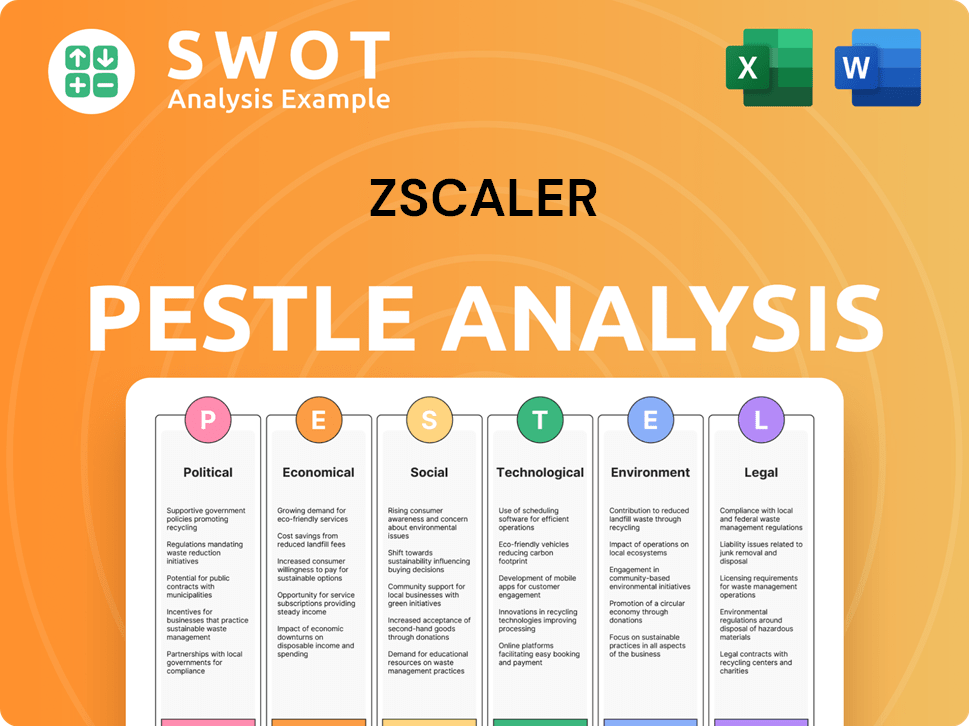
Which Strategic Decisions Have Shaped Zscaler’s Business Model?
The journey of Zscaler has been marked by significant milestones that have shaped its operations and financial performance. A crucial early move was recognizing the shift from traditional network perimeters to a cloud-centric security model. Its initial public offering (IPO) in 2018 was a pivotal step, providing capital for aggressive expansion and technological innovation. Subsequent product launches, such as the continuous enhancement of its Zero Trust Exchange platform, Zscaler Internet Access (ZIA), and Zscaler Private Access (ZPA), have solidified its market leadership by consistently addressing evolving cybersecurity challenges.
Strategic partnerships with major cloud providers and technology companies have also been crucial in extending its reach and integrating its platform within broader enterprise IT ecosystems. The company has navigated operational and market challenges, including intense competition in the cybersecurity space and the need to continuously innovate against sophisticated cyber threats. Zscaler has responded by consistently investing heavily in research and development, evidenced by its continuous introduction of new features and services. For example, the integration of AI and machine learning into its threat detection capabilities has been a strategic move to maintain its technological edge.
Zscaler's competitive advantages are multifaceted. Its pioneering cloud-native architecture offers superior scalability, performance, and security efficacy compared to legacy appliance-based solutions. The sheer scale of its global cloud infrastructure, processing trillions of transactions daily, provides an unparalleled source of threat intelligence, creating a powerful network effect. This extensive data allows Zscaler to rapidly identify and neutralize new threats, enhancing its overall security posture. Furthermore, its 'zero trust' security model, which assumes no user or device can be trusted by default, aligns perfectly with modern security best practices and provides a fundamental differentiation. Zscaler continues to adapt to new trends like the rise of generative AI and the increasing complexity of hybrid work environments by expanding its platform to secure these emerging use cases, ensuring its business model remains resilient and relevant in a dynamic threat landscape.
Zscaler's early recognition of the shift to cloud security was crucial. The 2018 IPO provided capital for expansion. Continuous product enhancements, like ZIA and ZPA, have solidified its market position.
Strategic partnerships with major cloud providers have expanded Zscaler's reach. Heavy investment in R&D, including AI and machine learning, has been consistent. Adapting to new trends like generative AI is key.
Cloud-native architecture offers superior scalability and security. A global cloud infrastructure provides unparalleled threat intelligence. The 'zero trust' model aligns with modern security practices.
In fiscal year 2024, Zscaler reported revenues of over $1.7 billion, a significant increase from the previous year. The company's gross margin remained strong, reflecting the efficiency of its cloud-based services. Zscaler's customer base continues to grow, with the addition of new large enterprise clients.
Zscaler's cloud-native architecture is a key differentiator, offering superior performance and scalability. Its global cloud infrastructure provides a vast source of threat intelligence, enabling rapid threat detection and response. The zero-trust security model is fundamental to its approach.
- Cloud-Native Architecture: Offers better scalability and performance compared to legacy solutions.
- Global Cloud Infrastructure: Processes trillions of transactions daily, providing extensive threat intelligence.
- Zero Trust Security: Aligns with modern security best practices.
- Strategic Partnerships: Collaborations with major cloud providers.
- Continuous Innovation: Investment in R&D, including AI and machine learning.
Zscaler Business Model Canvas
- Complete 9-Block Business Model Canvas
- Effortlessly Communicate Your Business Strategy
- Investor-Ready BMC Format
- 100% Editable and Customizable
- Clear and Structured Layout
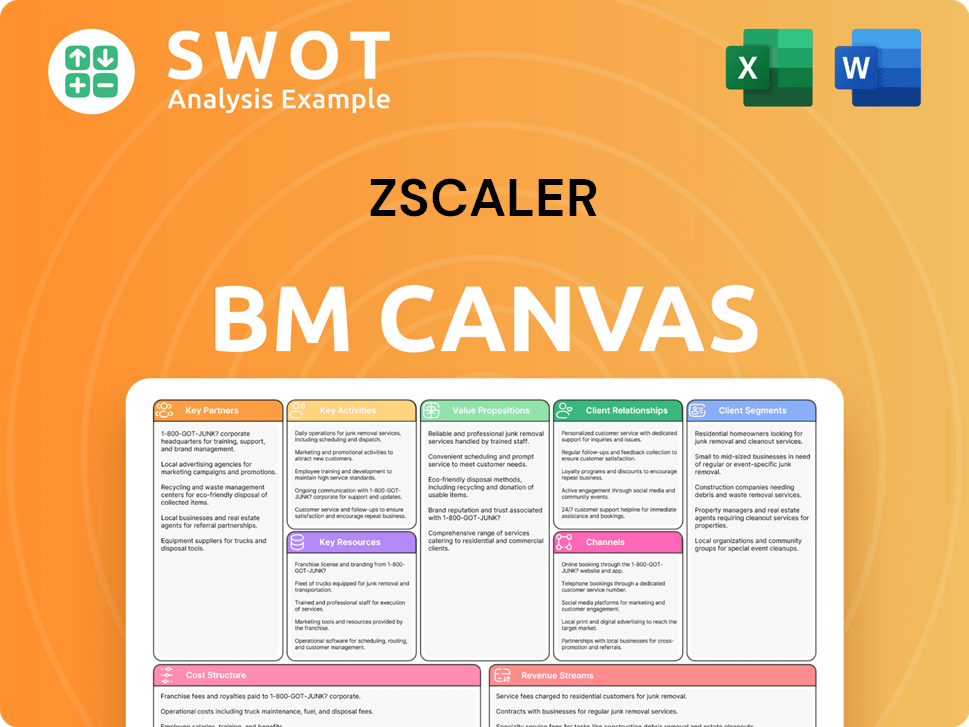
How Is Zscaler Positioning Itself for Continued Success?
Zscaler holds a prominent position in the cybersecurity sector, especially in the Secure Access Service Edge (SASE) and Zero Trust Network Access (ZTNA) markets. The company is consistently recognized as a leader in Gartner's Magic Quadrant for Security Service Edge (SSE). This recognition highlights its strong vision and execution capabilities. Zscaler serves a considerable customer base, including a significant portion of the Global 2000, demonstrating strong customer loyalty and broad market adoption. Its global reach, with over 150 data centers worldwide, allows it to deliver low-latency, high-performance security services across diverse geographical locations.
However, Zscaler faces several key risks. Intense competition from established and emerging players in the SASE space could impact its market share and pricing. Rapid technological advancements in cyber threats require continuous investment in research and development, which puts pressure on profitability. Regulatory changes concerning data privacy and cross-border data flows could also impact operations. Economic downturns or shifts in enterprise IT spending could affect customer adoption rates and subscription renewals.
Zscaler is a leader in the SASE and ZTNA markets, consistently recognized in Gartner's Magic Quadrant for SSE. It has a strong customer base, including a significant portion of the Global 2000. Its extensive global infrastructure, with over 150 data centers, provides low-latency security services worldwide.
Zscaler faces competition from established and emerging players in the SASE space. Continuous investment in R&D is crucial due to rapid technological advancements. Regulatory changes and economic shifts can also impact the company. These factors could affect Zscaler's market share and profitability.
Zscaler is focused on expanding its platform capabilities and market reach. The company is investing in AI and machine learning to enhance threat detection. It aims to capture a larger share of the SASE market, addressing evolving security needs. The company plans to sustain and expand its revenue generation by continuing to innovate.
Zscaler is actively investing in AI and machine learning to enhance its threat detection and prevention capabilities. Leadership emphasizes the continued transition of enterprises to cloud-delivered security and the growing adoption of zero trust principles, which are core to Zscaler's offerings. The company plans to sustain and expand its revenue generation by continuing to innovate.
Zscaler's future hinges on expanding its platform and market reach. Investments in AI and machine learning are crucial for proactive security. The company is focused on the cloud and zero trust principles.
- Focus on cloud-delivered security and zero trust.
- Investment in AI and machine learning for advanced threat detection.
- Expansion of platform capabilities and market reach.
- Continued innovation to address evolving security needs.
Zscaler Porter's Five Forces Analysis
- Covers All 5 Competitive Forces in Detail
- Structured for Consultants, Students, and Founders
- 100% Editable in Microsoft Word & Excel
- Instant Digital Download – Use Immediately
- Compatible with Mac & PC – Fully Unlocked
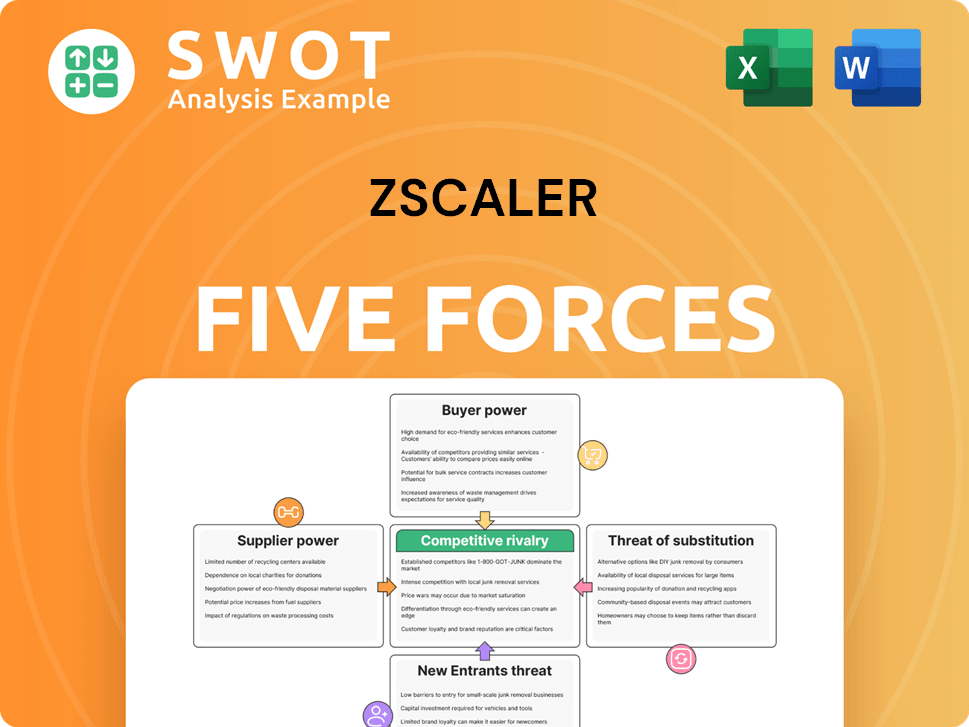
Related Blogs
- What are Mission Vision & Core Values of Zscaler Company?
- What is Competitive Landscape of Zscaler Company?
- What is Growth Strategy and Future Prospects of Zscaler Company?
- What is Sales and Marketing Strategy of Zscaler Company?
- What is Brief History of Zscaler Company?
- Who Owns Zscaler Company?
- What is Customer Demographics and Target Market of Zscaler Company?
Disclaimer
All information, articles, and product details provided on this website are for general informational and educational purposes only. We do not claim any ownership over, nor do we intend to infringe upon, any trademarks, copyrights, logos, brand names, or other intellectual property mentioned or depicted on this site. Such intellectual property remains the property of its respective owners, and any references here are made solely for identification or informational purposes, without implying any affiliation, endorsement, or partnership.
We make no representations or warranties, express or implied, regarding the accuracy, completeness, or suitability of any content or products presented. Nothing on this website should be construed as legal, tax, investment, financial, medical, or other professional advice. In addition, no part of this site—including articles or product references—constitutes a solicitation, recommendation, endorsement, advertisement, or offer to buy or sell any securities, franchises, or other financial instruments, particularly in jurisdictions where such activity would be unlawful.
All content is of a general nature and may not address the specific circumstances of any individual or entity. It is not a substitute for professional advice or services. Any actions you take based on the information provided here are strictly at your own risk. You accept full responsibility for any decisions or outcomes arising from your use of this website and agree to release us from any liability in connection with your use of, or reliance upon, the content or products found herein.